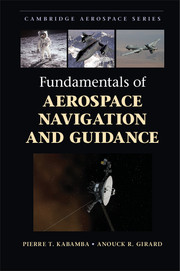Book contents
- Frontmatter
- Dedication
- Contents
- Preface
- 1 Introduction
- 2 Deterministic Systems Theory
- 3 Stochastic Systems Theory
- 4 Navigation
- 5 Homing Guidance
- 6 Ballistic Guidance
- 7 Midcourse Guidance
- 8 Optimization
- 9 Optimal Guidance
- 10 Introduction to Differential Games
- Epilogue
- APPENDIX A Useful Definitions and Mathematical Results
- Bibliography
- Index
Epilogue
Published online by Cambridge University Press: 05 October 2014
- Frontmatter
- Dedication
- Contents
- Preface
- 1 Introduction
- 2 Deterministic Systems Theory
- 3 Stochastic Systems Theory
- 4 Navigation
- 5 Homing Guidance
- 6 Ballistic Guidance
- 7 Midcourse Guidance
- 8 Optimization
- 9 Optimal Guidance
- 10 Introduction to Differential Games
- Epilogue
- APPENDIX A Useful Definitions and Mathematical Results
- Bibliography
- Index
Summary
During this 10-chapter journey through Fundamentals of Aerospace Navigation and Guidance, the book endeavors to give an orderly account of the lay of this land. This orderliness should now be apparent through synergies between many items. By this we mean that, often, a newly introduced fundamental relies on past fundamentals, sheds new light on some of them, and foreshadows future ones. Let us give examples of such synergies.
Inequality (1.2) establishes that, in static systems, good navigation combined with good navigation-based guidance guarantees good guidance. This principle is extended to deterministic linear dynamic systems through inequality (7.54) under the umbrella of the deterministic separation principle. Then, it is further extended to systems with linear dynamics, quadratic cost, and Gaussian noise processes in Section 9.5.6 under the umbrella of the stochastic separation principle.
The controllability Gramian is introduced in Proposition 2.22 to settle the binary question of controllability of a state. However, after deriving optimization results in Section 8.4 and extending them to optimal control in Section 9.3, we show in Example 9.6 that the same controllability Gramian can also be used as a quantitative measure of controllability through (9.54).
The implicit function theorem, introduced in Section 6.3 to analyze the accuracy of ballistic shots, is also used in Proposition 8.6 to establish the existence of Lagrange multipliers in constrained optimization. This result is extended in Sections 8.4 and 9.3 to establish the existence of the time varying co-state vector.
- Type
- Chapter
- Information
- Fundamentals of Aerospace Navigation and Guidance , pp. 288 - 294Publisher: Cambridge University PressPrint publication year: 2014

